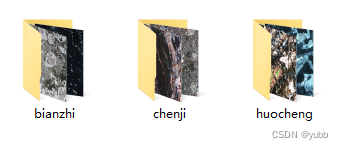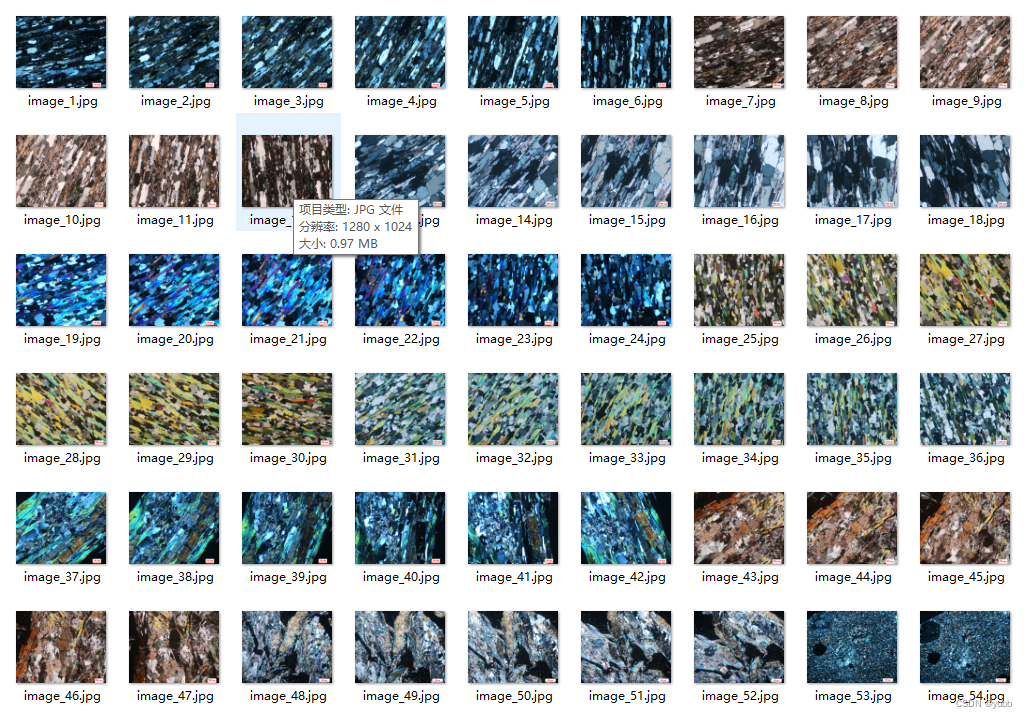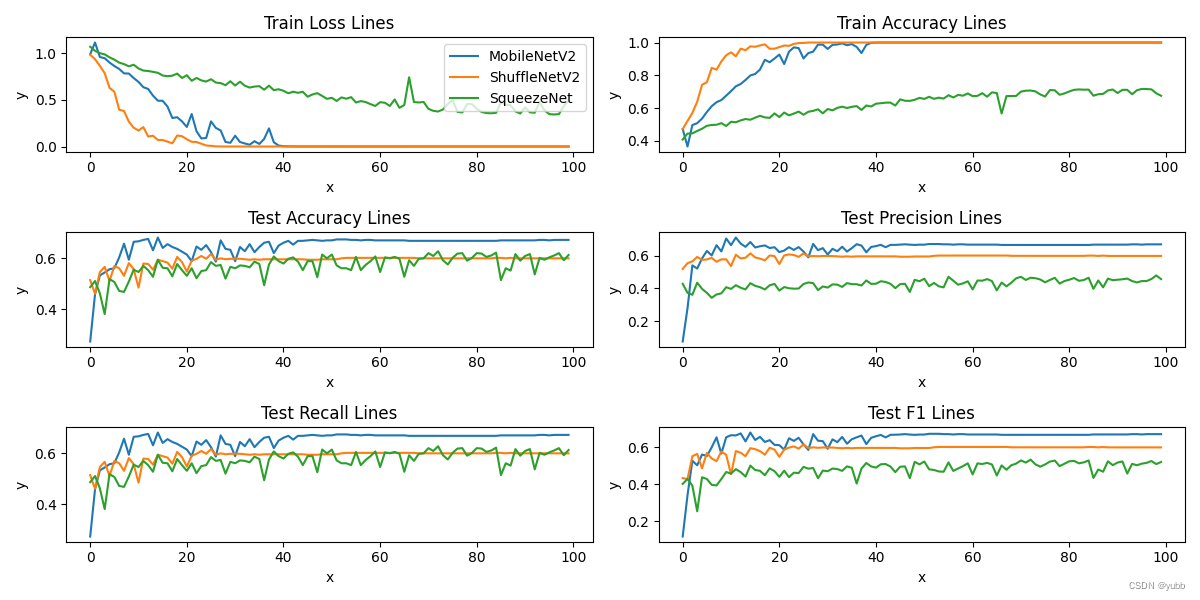轻量级算法
目前较流行的轻量级算法有很多,但是文章里主要用了MobileNetV2、ShuffleNetV2、SqueezeNet三种,但是对于千级的数据集还是需要很长的处理时间
前言
对比了三种轻量级算法,有MobileNetV2、ShuffleNetV2、SqueezeNet,做岩石图片的三分类
一、数据集
采用的是南京大学岩石薄片教学公开数据集,南京大学岩石薄片数据集,手动分成训练集和测试集,

二、算法实现
1.导包
代码如下(示例):
import torch
import torch.nn as nn
import torch.optim as optim
from torchvision import models, transforms
from torchvision.datasets import ImageFolder
from torch.utils.data import DataLoader
from sklearn.metrics import accuracy_score, recall_score, f1_score, precision_score
import csv
import datetime2.图像归一化
代码如下(示例):
# 数据预处理
transform = transforms.Compose([
transforms.Resize(224),
transforms.CenterCrop(224),
transforms.ToTensor(),
transforms.Normalize(mean=[0.485, 0.456, 0.406], std=[0.229, 0.224, 0.225])
])
# 加载数据集
train_dataset = ImageFolder('../202310/Stone-image/train', transform=transform)
test_dataset = ImageFolder('../202310/Stone-image/test', transform=transform)
train_loader = DataLoader(train_dataset, batch_size=32, shuffle=True)
test_loader = DataLoader(test_dataset, batch_size=32, shuffle=False)
3.加载模型
三种算法都是类似的,可以直接从pytorch官网上找到
# 初始化模型并设置输出类别数为3
model = models.shufflenet_v2_x1_0(num_classes=3)
# 定义损失函数和优化器
criterion = nn.CrossEntropyLoss()
optimizer = optim.Adam(model.parameters(), lr=0.0001)4.训练模型
# 训练循环
num_epochs = 100
for epoch in range(num_epochs):
running_loss = 0.0
correct = 0
total = 0
for inputs, labels in train_loader:
optimizer.zero_grad()
outputs = model(inputs)
loss = criterion(outputs, labels)
loss.backward()
optimizer.step()
running_loss += loss.item() * inputs.size(0)
_, predicted = torch.max(outputs.data, 1)
total += labels.size(0)
correct += (predicted == labels).sum().item()
train_loss = running_loss / total
train_accuracy = correct / total
# 在测试集上评估模型
with torch.no_grad():
model.eval()
test_correct = 0
test_total = 0
test_pred = []
test_true = []
for inputs, labels in test_loader:
outputs = model(inputs)
_, predicted = torch.max(outputs.data, 1)
test_total += labels.size(0)
test_correct += (predicted == labels).sum().item()
test_accuracy = test_correct / test_total
test_precision = precision_score(test_true, test_pred, average='weighted',zero_division=0)
test_recall = recall_score(test_true, test_pred, average='weighted',zero_division=0)
test_f1 = f1_score(test_true, test_pred, average='weighted',zero_division=0)
print(f'Epoch [{epoch + 1}/{num_epochs}], Train Loss: {train_loss:.4f}, Train Accuracy: {train_accuracy:.4f}')
print(f'Test Accuracy: {test_accuracy:.4f}, Test Precision: {test_precision:.4f}, Test Recall: {test_recall:.4f}, Test F1: {test_f1:.4f}')
# 输出最终测试集上的精确率、召回率和F1值
print(f"Final Test Results: Accuracy={test_accuracy:.4f}, Precision={test_precision:.4f}, Recall={test_recall:.4f}, F1 Score={test_f1:.4f}")
test_accuracy1.write(f"ShuffleNetV2 Final Test Results: Accuracy={test_accuracy:.4f}, Precision={test_precision:.4f}, Recall={test_recall:.4f}, F1 Score={test_f1:.4f}")
5.算法对比
plt.figure(figsize=(12, 6))
plt.subplot(3, 2, 1)
plt.plot(x, y1_loss, label='MobileNetV2')
plt.plot(x, y2_loss, label='ShuffleNetV2')
plt.plot(x, y3_loss, label='SqueezeNet')
plt.title('Train Loss Lines')
plt.legend()
plt.xlabel('x')
plt.ylabel('y')
plt.subplot(3, 2, 2)
plt.plot(x, y1_train_accuracy, label='MobileNetV2')
plt.plot(x, y2_train_accuracy, label='ShulleNetV2')
plt.plot(x, y3_train_accuracy, label='SqueezeNet')
plt.title('Train Accuracy Lines')
plt.xlabel('x')
plt.ylabel('y')
plt.subplot(3, 2, 3)
plt.plot(x, y1_accuracy, label='MobileNetV2')
plt.plot(x, y2_accuracy, label='ShulleNetV2')
plt.plot(x, y3_accuracy, label='SqueezeNet')
plt.title('Test Accuracy Lines')
plt.xlabel('x')
plt.ylabel('y')
plt.subplot(3, 2, 4)
plt.plot(x, y1_precision, label='MobileNetV2')
plt.plot(x, y2_precision, label='ShulleNetV2')
plt.plot(x, y3_precision, label='SqueezeNet')
plt.title('Test Precision Lines')
plt.xlabel('x')
plt.ylabel('y')
plt.subplot(3, 2, 5)
plt.plot(x, y1_recall, label='MobileNetV2')
plt.plot(x, y2_recall, label='ShulleNetV2')
plt.plot(x, y3_recall, label='SqueezeNet')
plt.title('Test Recall Lines')
plt.xlabel('x')
plt.ylabel('y')
plt.subplot(3, 2, 6)
plt.plot(x, y1_f1, label='MobileNetV2')
plt.plot(x, y2_f1, label='ShulleNetV2')
plt.plot(x, y3_f1, label='SqueezeNet')
plt.title('Test F1 Lines')
plt.xlabel('x')
plt.ylabel('y')
# 调整子图参数,使之填充整个图像区域
plt.tight_layout()
# 显示图形
plt.show()
在训练集上ShuffleNet的收敛速度更快,在测试集上MobileNet的精度更高,各有千秋,ShuffleNet 是由于加入了通道混洗的模块所以在训练速度上更快。
总结
整个流程就是如上,如果能结合两种算法的优点就更好了,做到模型融合。





















 3224
3224











 被折叠的 条评论
为什么被折叠?
被折叠的 条评论
为什么被折叠?








